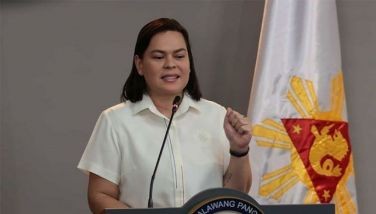Dil Se: A subtle tale of doomed love
March 13, 2005 | 12:00am
The author, 22, lives in Alabang. He finished Criminology and Psychology at the London Metropolitan University. He watches a lot of foreign films, particularly Indian ones which he says, ‘has a lot of elements that will appeal to Filipinos.’
At a remote train station in northeast India a young reporter’s heart melts at the sight of a bedraggled woman shivering in the rain. She asks for hot tea in a voice as pure as falling pearls. As he rushes to fulfill her request she steps into a train, leaving him with two watery cups of tea and a bittersweet shake of the head. And so the story begins..
The movie touches on terrorism and civil unrest, issues that nowadays dominate world current affairs. Yet behind these somber topics lies a simple love story, like a sonnet brought to life. As the plot progresses the hero Amar, an idealistic journalist, is presented as going through the seven shades of love spoken of in ancient Arabic literature: hub (attraction), uns (infatuation), ishq (love), aquidat (reverence), ibaadat (worship), junoon (obsession) and maut (death) as he pursues the elusive Meghna.
I have been a fan of Indian (Hindi) movies ever since a friend made me watch one about five years ago. Something about their films appeal to the drama queen/romantic within me. I usually buy VCDs from the Little India area in Singapore, where you can get good copies with English subtitles. Dil Se (translation: From the heart/with all my heart) remains one of my favorites, so much so that I went and bought a DVD copy, as well as the soundtrack, which borrows a lot from traditional music (my favorite song in the movie is the haunting Ae Ajnabi). True story: after watching this movie, Andrew Lloyd Webber contacted A R Rahman, the man in charge of Dil Se’s musical score to work with him in his Broadway production, Bombay Dreams.
Hindi movies are known for their elaborate song and dance sequences, gorgeous actresses in lavish saris and mastery of the romantic escapism theme. Yet Dil Se goes against this basic formula, with interesting results. The heroine is not a virginal demi-goddess but a tormented and flawed woman. There are no glamorous on location shots in London or New York. There are however, excellent shots of arid Ladakh and the backwaters of Kerala. And instead of the usual ‘they lived happily ever after with lots of singing and dancing at the wedding’ ending, you get a Greek tragedy on stilts. This is the strength of the film (a cult hit worldwide) as well as its downfall (a flop in India).
The first half of the film takes place in the northern borders of India and Pakistan–the Kashmir region. Amar is a radio reporter from Mumbai on assignment when he happens upon the enigmatic Meghna. Something about her and her haunting eyes drives him from hub to junoon and he tracks her relentlessly from mountains to desert and beyond. The second half finds Amar back in Mumbai, somewhat recovered from his delirium of passion only for Meghna to reappear, seeking his help. Finally, the truth behind her mystery is revealed and Amar has to choose between life or Meghna.
The movie comes to a close during the 50th anniversary of India’s independence and alludes to the assassination of Rajiv Gandhi. Mani Ratnam (the director) appears to have a preoccupation with politics, as his most famous films (Bombay and Roja) also have a socio-political context. Ratnam is known for his use of imagery and technical detail, both of which are superbly executed in Dil Se. The cinematography is exquisite, as is the choreography. The natural beauty of India is shown with its mountain ranges, rocky deserts, and flowing rivers. Some of the settings in song and dance sequences can be described as fluid paintings, particularly with the song Satrangi Re. The sequence for another song, Chaiyya Chaiyya done on top of a running train with an energetic Amar and dozens of traditional dancers is legendary in Indian cinema. During the second part, the shots become more gritty as the story continues into the capital. The simple use of lighting when Amar tries to have a private conversation with Meghna in the radio station is jarring but works well.
Be warned: Dil Se is not easy viewing. Most Hindi movies are about three hours long, so this is definitely not for the faint of heart! But it’s definitely worth it. Shah Rukh Khan, the actor who plays Amar is the Megastar of Indian cinema. He gives a great performance as the enamored Amar, a naïve smart aleck who doesn’t know when to give up. Manisha Koirala excels with her restrained portrayal of the emotionally scarred Meghna. A lesser actress couldn’t have pulled off the scene where her mouth hangs open in terror, a physical reflex caused by past trauma believably, yet she manages to do so in an affecting, un-melodramatic way.
My favorite part of the film is Amar and Meghna’s journey through the desert, when Meghna hesitantly allows Amar a glimpse into her heart. I think this is the film’s highlight, when the two characters connect for one brief moonlit moment. The ending makes one wonder- is Meghna’s ‘proof of love’ really such, or is she simply tired- of her tormented past, her harsh life, of being chased by Amar? I’m not fully convinced that Amar’s feelings go beyond uns, coupled with a journalist’s hazardous need to know the truth. And once his family background is revealed, more doubts appear; in the end, is he spurred on by blind, obsessive love or a sense of patriotic duty?
For me, nothing can detract from the film’s beauty. It is technically sophisticated, has impressive acting and depth. The glimpse into terrorism and rebellion is educational, as opposed to frightening or propaganda laden. But the movie is simply about love, and shows the finest as well as the darkest qualities of the emotion with a poignant intensity. It’s not a movie with mass appeal and that feel-good factor craved by most, but if you’re patient and like things that are intricate yet simple, rich yet sparse, then Dil Se will draw you in with its subtle tale of doomed love.
At a remote train station in northeast India a young reporter’s heart melts at the sight of a bedraggled woman shivering in the rain. She asks for hot tea in a voice as pure as falling pearls. As he rushes to fulfill her request she steps into a train, leaving him with two watery cups of tea and a bittersweet shake of the head. And so the story begins..
The movie touches on terrorism and civil unrest, issues that nowadays dominate world current affairs. Yet behind these somber topics lies a simple love story, like a sonnet brought to life. As the plot progresses the hero Amar, an idealistic journalist, is presented as going through the seven shades of love spoken of in ancient Arabic literature: hub (attraction), uns (infatuation), ishq (love), aquidat (reverence), ibaadat (worship), junoon (obsession) and maut (death) as he pursues the elusive Meghna.
I have been a fan of Indian (Hindi) movies ever since a friend made me watch one about five years ago. Something about their films appeal to the drama queen/romantic within me. I usually buy VCDs from the Little India area in Singapore, where you can get good copies with English subtitles. Dil Se (translation: From the heart/with all my heart) remains one of my favorites, so much so that I went and bought a DVD copy, as well as the soundtrack, which borrows a lot from traditional music (my favorite song in the movie is the haunting Ae Ajnabi). True story: after watching this movie, Andrew Lloyd Webber contacted A R Rahman, the man in charge of Dil Se’s musical score to work with him in his Broadway production, Bombay Dreams.
Hindi movies are known for their elaborate song and dance sequences, gorgeous actresses in lavish saris and mastery of the romantic escapism theme. Yet Dil Se goes against this basic formula, with interesting results. The heroine is not a virginal demi-goddess but a tormented and flawed woman. There are no glamorous on location shots in London or New York. There are however, excellent shots of arid Ladakh and the backwaters of Kerala. And instead of the usual ‘they lived happily ever after with lots of singing and dancing at the wedding’ ending, you get a Greek tragedy on stilts. This is the strength of the film (a cult hit worldwide) as well as its downfall (a flop in India).
The first half of the film takes place in the northern borders of India and Pakistan–the Kashmir region. Amar is a radio reporter from Mumbai on assignment when he happens upon the enigmatic Meghna. Something about her and her haunting eyes drives him from hub to junoon and he tracks her relentlessly from mountains to desert and beyond. The second half finds Amar back in Mumbai, somewhat recovered from his delirium of passion only for Meghna to reappear, seeking his help. Finally, the truth behind her mystery is revealed and Amar has to choose between life or Meghna.
The movie comes to a close during the 50th anniversary of India’s independence and alludes to the assassination of Rajiv Gandhi. Mani Ratnam (the director) appears to have a preoccupation with politics, as his most famous films (Bombay and Roja) also have a socio-political context. Ratnam is known for his use of imagery and technical detail, both of which are superbly executed in Dil Se. The cinematography is exquisite, as is the choreography. The natural beauty of India is shown with its mountain ranges, rocky deserts, and flowing rivers. Some of the settings in song and dance sequences can be described as fluid paintings, particularly with the song Satrangi Re. The sequence for another song, Chaiyya Chaiyya done on top of a running train with an energetic Amar and dozens of traditional dancers is legendary in Indian cinema. During the second part, the shots become more gritty as the story continues into the capital. The simple use of lighting when Amar tries to have a private conversation with Meghna in the radio station is jarring but works well.
Be warned: Dil Se is not easy viewing. Most Hindi movies are about three hours long, so this is definitely not for the faint of heart! But it’s definitely worth it. Shah Rukh Khan, the actor who plays Amar is the Megastar of Indian cinema. He gives a great performance as the enamored Amar, a naïve smart aleck who doesn’t know when to give up. Manisha Koirala excels with her restrained portrayal of the emotionally scarred Meghna. A lesser actress couldn’t have pulled off the scene where her mouth hangs open in terror, a physical reflex caused by past trauma believably, yet she manages to do so in an affecting, un-melodramatic way.
My favorite part of the film is Amar and Meghna’s journey through the desert, when Meghna hesitantly allows Amar a glimpse into her heart. I think this is the film’s highlight, when the two characters connect for one brief moonlit moment. The ending makes one wonder- is Meghna’s ‘proof of love’ really such, or is she simply tired- of her tormented past, her harsh life, of being chased by Amar? I’m not fully convinced that Amar’s feelings go beyond uns, coupled with a journalist’s hazardous need to know the truth. And once his family background is revealed, more doubts appear; in the end, is he spurred on by blind, obsessive love or a sense of patriotic duty?
For me, nothing can detract from the film’s beauty. It is technically sophisticated, has impressive acting and depth. The glimpse into terrorism and rebellion is educational, as opposed to frightening or propaganda laden. But the movie is simply about love, and shows the finest as well as the darkest qualities of the emotion with a poignant intensity. It’s not a movie with mass appeal and that feel-good factor craved by most, but if you’re patient and like things that are intricate yet simple, rich yet sparse, then Dil Se will draw you in with its subtle tale of doomed love.
BrandSpace Articles
<
>
- Latest
- Trending
Trending
Latest
Trending
Latest
Recommended

































